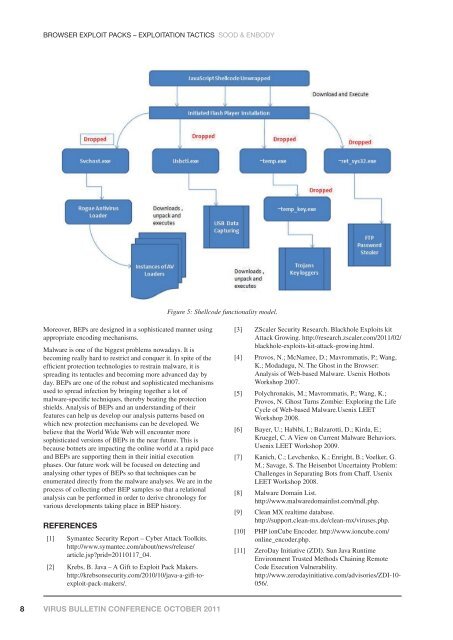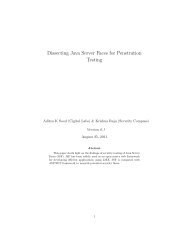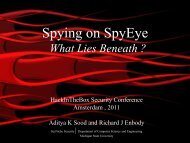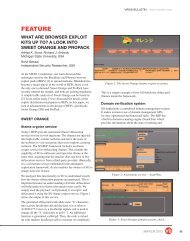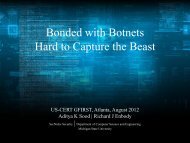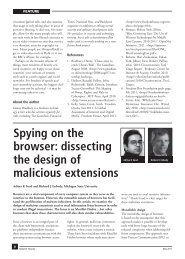browser exploit packs â exploitation tactics - SecNiche Security Labs
browser exploit packs â exploitation tactics - SecNiche Security Labs
browser exploit packs â exploitation tactics - SecNiche Security Labs
You also want an ePaper? Increase the reach of your titles
YUMPU automatically turns print PDFs into web optimized ePapers that Google loves.
BROWSER EXPLOIT PACKS – EXPLOITATION TACTICS SOOD & ENBODY<br />
Figure 5: Shellcode functionality model.<br />
Moreover, BEPs are designed in a sophisticated manner using<br />
appropriate encoding mechanisms.<br />
Malware is one of the biggest problems nowadays. It is<br />
becoming really hard to restrict and conquer it. In spite of the<br />
efficient protection technologies to restrain malware, it is<br />
spreading its tentacles and becoming more advanced day by<br />
day. BEPs are one of the robust and sophisticated mechanisms<br />
used to spread infection by bringing together a lot of<br />
malware-specific techniques, thereby beating the protection<br />
shields. Analysis of BEPs and an understanding of their<br />
features can help us develop our analysis patterns based on<br />
which new protection mechanisms can be developed. We<br />
believe that the World Wide Web will encounter more<br />
sophisticated versions of BEPs in the near future. This is<br />
because botnets are impacting the online world at a rapid pace<br />
and BEPs are supporting them in their initial execution<br />
phases. Our future work will be focused on detecting and<br />
analysing other types of BEPs so that techniques can be<br />
enumerated directly from the malware analyses. We are in the<br />
process of collecting other BEP samples so that a relational<br />
analysis can be performed in order to derive chronology for<br />
various developments taking place in BEP history.<br />
REFERENCES<br />
[1] Symantec <strong>Security</strong> Report – Cyber Attack Toolkits.<br />
http://www.symantec.com/about/news/release/<br />
article.jsp?prid=20110117_04.<br />
[2] Krebs, B. Java – A Gift to Exploit Pack Makers.<br />
http://krebsonsecurity.com/2010/10/java-a-gift-to<strong>exploit</strong>-pack-makers/.<br />
[3] ZScaler <strong>Security</strong> Research. Blackhole Exploits kit<br />
Attack Growing. http://research.zscaler.com/2011/02/<br />
blackhole-<strong>exploit</strong>s-kit-attack-growing.html.<br />
[4] Provos, N.; McNamee, D.; Mavrommatis, P.; Wang,<br />
K.; Modadugu, N. The Ghost in the Browser:<br />
Analysis of Web-based Malware. Usenix Hotbots<br />
Workshop 2007.<br />
[5] Polychronakis, M.; Mavrommatis, P.; Wang, K.;<br />
Provos, N. Ghost Turns Zombie: Exploring the Life<br />
Cycle of Web-based Malware.Usenix LEET<br />
Workshop 2008.<br />
[6] Bayer, U.; Habibi, I.; Balzarotti, D.; Kirda, E.;<br />
Kruegel, C. A View on Current Malware Behaviors.<br />
Usenix LEET Workshop 2009.<br />
[7] Kanich, C.; Levchenko, K.; Enright, B.; Voelker, G.<br />
M.; Savage, S. The Heisenbot Uncertainty Problem:<br />
Challenges in Separating Bots from Chaff. Usenix<br />
LEET Workshop 2008.<br />
[8] Malware Domain List.<br />
http://www.malwaredomainlist.com/mdl.php.<br />
[9] Clean MX realtime database.<br />
http://support.clean-mx.de/clean-mx/viruses.php.<br />
[10] PHP ionCube Encoder. http://www.ioncube.com/<br />
online_encoder.php.<br />
[11] ZeroDay Initiative (ZDI). Sun Java Runtime<br />
Environment Trusted Methods Chaining Remote<br />
Code Execution Vulnerability.<br />
http://www.zerodayinitiative.com/advisories/ZDI-10-<br />
056/.<br />
8 VIRUS BULLETIN CONFERENCE OCTOBER 2011


